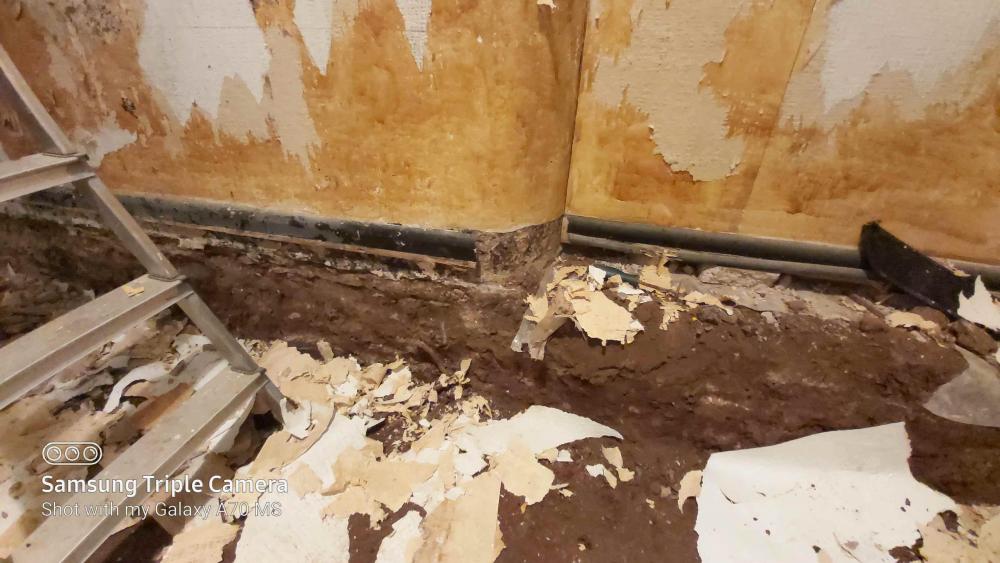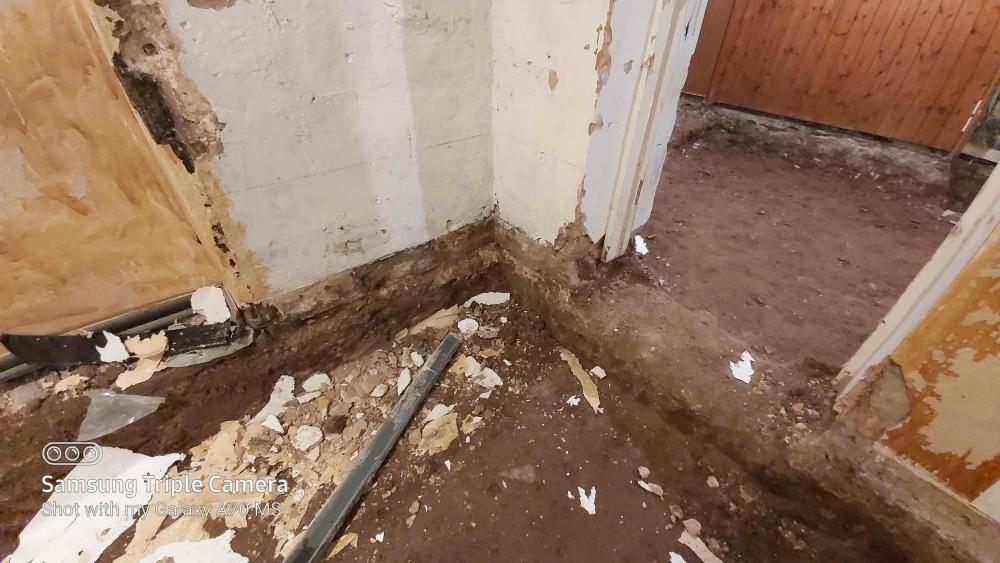
strideredc
Members-
Posts
21 -
Joined
Recent Profile Visitors
The recent visitors block is disabled and is not being shown to other users.
strideredc's Achievements

Member (3/5)
5
Reputation
-
Got a few niggling questions for the plumbers out there.... I have run 28mm copper pipe from where the monobloc will sit outside to the plant room upstairs in the spare room. the total run one way I.e flow is about 9m ish (return almost identical) and it then hits the 3 port valve (28mm connections and then about .5m into a 250l buffer tank and 300l hp dhw cylinder with a low resistance 3m2 coil. Its going up prob about 5m from heatpump to plant room. not sure what make of heatpump to buy yet but it needs to be 16kw (heat loss is about 13kw ish at -3 deg) most seem to state a max flow rate of 3m3 per hour and min of about 1.8m3 per hour. should I have gone 32mm copper for the flow and return to be on the safe side or will 28mm copper be ok???
-
Old stone converted stable vs plaster damp issues...
strideredc replied to strideredc's topic in Plastering & Rendering
thanks for the replies, the floor (not at the mo as its dug out for ufh) is level with the ground outside that consists of a cobblestone yard. no banking of earth or anything like that... I dont want to plaster and have it coming through. options are lime plaster, it's a big wall! then you have to use paint that costs a 100 quid a can! batton and insulate plasterboard with a membrane? -
it's going to be an unvented system with a 300l DHW tank upstairs being feed from a 28mm alkathane water main (outside) changing to a 32 mdpe across the house underground. when I tested the pressure it was over 4 bar and off the scale of the water flow measuring cup and that was through a 15mm pipe feeding a sink with probably 10mm bore hoses feeding the taps! close to where the existing water connections are...
-
just a quick one, when I run a balanced cold and hot from the DHW tank from one side of the house to the other (downstairs shower ,sink and toilet) I was going to run it in 22mm barrier pipe (it's going to be notched into the celotex floor below the UFH) question is 22m big enough or would you go 28mm? I might put a sec return in 15mm pipe? the total run is about 25m from tank to shower. can I also getaway with a 15mm sec return in barrier pipe?
-
Old stone converted stable vs plaster damp issues...
strideredc replied to strideredc's topic in Plastering & Rendering
there was on the floor we have taken up but not on the walls as they are 120+ years old -
Staring to get somewhere with the underfloor so now on to what to do with the plaster when we come to do it... below floor level its damp! it's been like this since it was converted in 1976 and looks a bit ropey but it's not to bad most of the old plaster needs to come off but what/how to replace it? its stone and rubble 1.5ft thick walls but what do we put in its place? as we are on a hill it's more the back wall as that's ground level where as the front is 5++ft above ground. the underfloor htg will heat the house much more evenly than before as it going to be on a ASHP but we dont want to plaster if damp is going to be a continuous issue... lots of the old issues were guttering (now fixed)and the drainage we can improve but we dont want to do something if it's wrong! it's only an issue going 8-10 inch up the walls. Any suggestions???
-
I am running it off a Ashp ( will be ) so would it be better to go thicker I am not after a fast heat up time particularly. it's an old house but looking for a slow steady background heat. will use log burner for when I really needs extra as have big supplies of wood and want to keep flow temps as low as poss for efficiency...
-
I read the quote. for 50mm of fast dry thet want a min 500 gauge membrane under the pipes on the top of the celotex. this is what happens when women relay things to you!!! anyway back to the screed... 50mm doesnt seem a lot what would you guys recommend as it's going to be laid on 150mm celotex on sand and compacted scalpings /type 1 what do you guys think??
-
I will phone them next week and speak to the myself see what they are on about!
-
when my wife spoke to the screed people she recons they said before they pour that they want another dpm over the top of the pipes??? I thought the screed went on top of the pipes that are on the dpm (main dpm is below the celotex ontop of the sand) what should the exact order be? my reckoning was type 1 compacted sand binding celotex (other brands are available!) dpm pipe clipped through dpm into celotex screed piped direct onto pipe to xxx level....
-
thanks for the replies, there will be no heavy partions on it just a stud work bedroom (put in for the disabled previous owner that we have the option of removing if we need latter) and a stud plasterboard bathroom... this is just slab of screed that will sit on a bed of celotex, 150mm I think we will go for. I dont want to go crazy deep due to footings on one side as the house is on a hill/slope...I could put 500mm+++ of celotex on the other side without hitting the ground on the other side!! what screed do you recommend? sand/cement, liquid, or concret? I presume the concrete is stronger? we had quotes for sand and liquid and there was 200 quid between them (sand/cement being cheaper) should we go a bit thicker?
-
After many wasted months we are starting work on it. it's a slow but almost full refurb...our builder is breaking up the existing 4/5 inch concrete slab and then digging down to give us the depth we need. the slab was put in above the existing sand and rubble floor with a dpm about 40 years ago.Never been any movement or cracking of the slab as our house sits on a sandstone hill and seems very solid The question I have is our builder wants to not put a new concrete sub slab in but to put scalpings in then wacker them down then bind with sand before laying a DPM then 150mm celotex on top... then pipes then another dpm (screed company want this before they pour) I thought you would need a new concrete slab then sand dpm insulation. I also spoke to a building contracts manager on a job nothing to do with us today and he said you can do it this way and you dont need a new concrete slab if it's done properly (our builder comes highly recommended and seems to know what hes doing... I am a controlls electrician so have no idea I just see jobs sometimes with pipe all put it. it's very confusing with lots of different opinions on this....
-
Our roof is supposed to be getting relaid as its not in great condition with tiles missing holes where it joins the brick. terrible lead flashing ect.. We have two experienced local guys that are going to do it but then the 'tile' question came up! no its not listed thank god! I have heard horror stories about imported slate (my sister owns a 5 year old bovis? home and all the oxides have run out. not just her but many 100's of residents are complaining about this) Wife said we will get welsh but thats way to expensive me thinks! i don't think she would know the difference between welsh and cement tile! There is also a large flat roof that our guys will get someone in to cover with rubber or glass resin? (so it can be guaranteed) I want to insulate under the flat and front roof with celotex but that's a question for another day!
-
Thats the $1m question, i dont know? i was going to get the outside facing walls re lime and hemp plastered (original is in a bit of a state)but i really dont know what to do with it all. there was signs of damp but i cant see any damp now and thats after the worst rain in years here! all the walls are dry apart from downstairs bathroom thats clad in wood that prob rotten underneath! the thought of rewiring it give me nightmares and i am an electrician! I only have floorboards in either end of the house and none on the mezz! 2x dbs are needed at either end of the house with swa under the slab and a few ducts put in to get from one side to the other. because of the construction its almost impossible to get from one side to the other...
-
just realized what you meant... not it was the 70's conversion dorma, aka box on the back to contain the 3 upstairs bedrooms...



